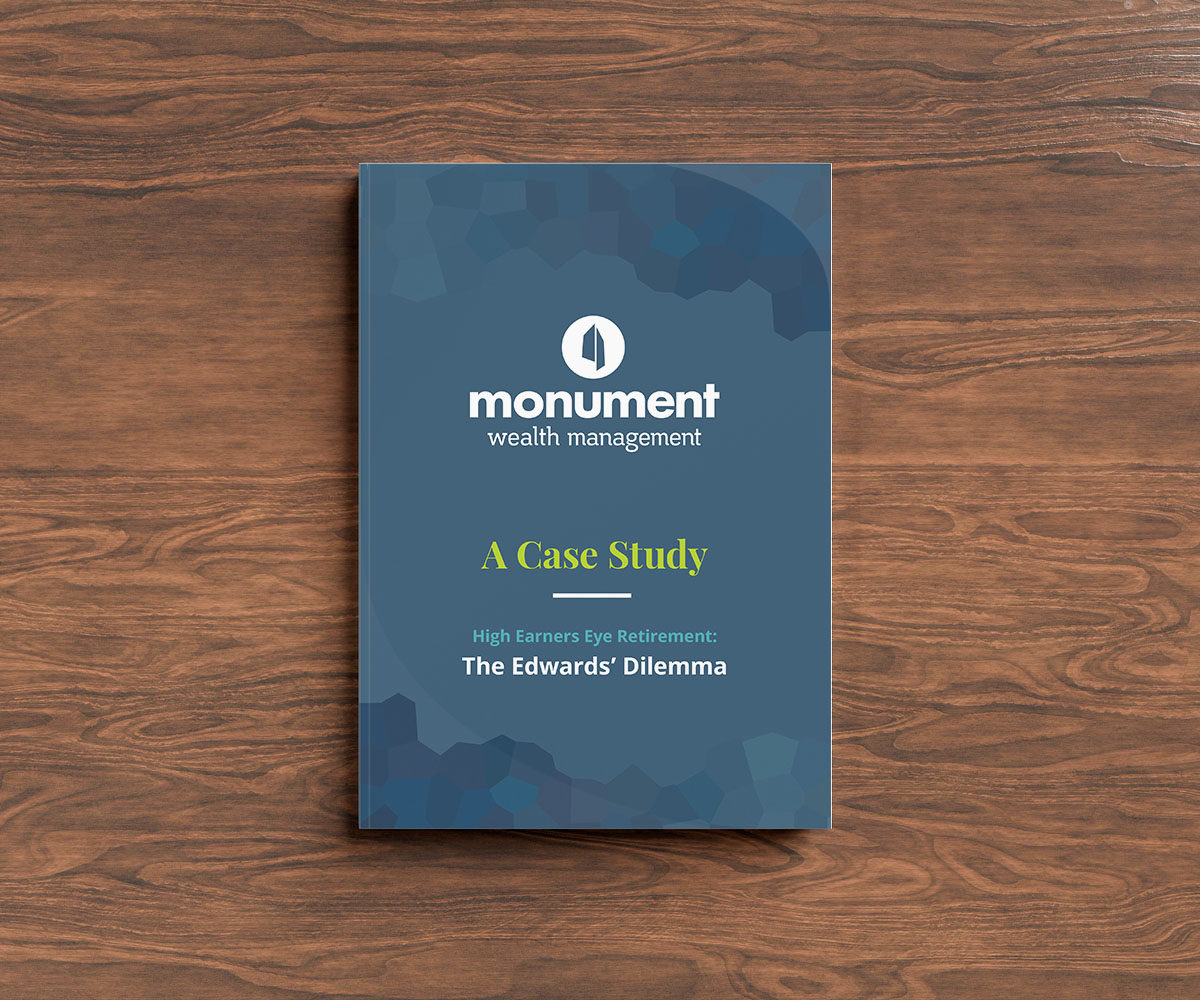Monument Resource Center
Our clients hire us because they recognize the value of our Team’s unique, straight-forward, unfiltered opinion and our tailored advice designed to answer their questions, not everyone else’s. Below, you’ll find some of the most important questions we have been asked over the years to help you better understand the role we play and the advice we give.
If losses hurt, psychologically, twice as much as gains bring joy – why would you ever sell a security at a loss if there are other options available? You may have asked yourself this at one point or another, particularly if you’ve come across the phrase “tax-loss harvesting.” So, what is tax-loss harvesting and what role does it play in your portfolio management?
What is tax-loss harvesting?
Tax-loss harvesting is the practice of selling a security that has experienced a loss and replacing it with a very similar security. The idea is that you will be able to apply these losses against any realized gains or income on your tax return to help lower your tax bill while maintaining an optimal asset allocation. Losses can be indefinitely carried forward and applied to offset future realized gains until they are exhausted.
Tax-loss harvesting is a strategy that only applies to taxable accounts.
When is tax-loss harvesting a good idea?
There are many situations where tax-loss harvesting can be beneficial, but some opportunities to consider tax-loss harvesting include:
- When the end of the tax year is approaching and you have already realized capital gains, securities that are trading at a loss can be sold to reduce or eliminate any capital gains tax liability.
- Losses can be harvested to offset some ordinary income in any calendar year.
- Rebalancing your portfolio is an opportunity to pair off any losses with gains while bringing portfolio allocations back into tolerance.
- Opportunities for tax-loss harvesting increase during periods of down-market volatility. By booking losses and immediately reinvesting in a like security, valuable tax losses can be booked for future use against gains while keeping your portfolio invested for a recovery.
How are losses applied to my taxes?
Once you have realized a loss from selling a security, it can then be used to offset your capital gains and potentially reduce your taxable income. Losses must be applied in a sequence, however, meaning that long-term losses must first be applied to long-term capital gains and then short-term capital gains. The opposite is true for short-term losses – first they are applied to short-term gains and then long-term gains.
After offsetting your capital gains, you are allowed to deduct up to $3,000 of capital losses from your ordinary income per year. If you still have losses left over after offsetting your capital gains and reducing your taxable income by the allowed amount, they can be carried forward for you to use in future years. If you have no realized capital gains to offset in future years, your losses can be carried over indefinitely, reduced by the $3,000 deduction from ordinary income each year, until they are gone.
What is the wash-sale rule and how does it relate to tax-loss harvesting?
This all sounds great… what’s the catch?
Tax-loss harvesting must be done carefully so as not to violate the IRS wash-sale rule. The wash-sale rule (IRC Section 1091) was created to prevent investors from claiming artificial losses on their taxes. The rule disallows the tax deduction of losses from a wash sale, meaning you won’t be able to take advantage of the tax benefit.
A wash sale occurs when you trade or sell a security at a loss and purchase the same, or a “substantially identical,” security within 61 days. The 61-day period comes from a 30-day window before the sale, the day the sale occurs, and another 30-day window following the sale.
You are allowed to “replace” the sold security during this time as long as the IRS doesn’t deem the replacement security substantially identical to the security you sold. Very few securities are considered truly identical, so replacement security selection is generally straightforward. Be sure to consult your accountant if you are tax-loss harvesting on your own.
Replacement security selection is important as part of your tax-loss harvesting efforts so you can maintain an optimal asset allocation and prevent exposure gaps in your portfolio. While selling a stock at a loss and sitting in cash books the loss, the benefit of this strategy resides in the portfolio staying fully invested for any potential rebound over the 30-day window following the sale.
Also notice the emphasis on loss in the earlier statement – a sale cannot be a wash sale if a security is sold for a profit.
We understand that thinking about tax-loss harvesting can be daunting; as a client of Monument, you can rest assured that someone always has an eye on the “tax-loss harvesting” ball for you. Our Private Wealth Advisors, including in-house portfolio managers, keep an eye on what’s happening with your entire Private Wealth Design, so we can respond to any changes or opportunities we see to improve performance – strategic tax-loss harvesting is just one part of the bigger picture. If you have any questions about tax-loss harvesting or are interested in the role it plays in your personal portfolio, reach out to the Monument Team for more information.

It’s time to find clarity around your finances and remove the anxiety of the unknown.
Read our case study, “High Earners Eye Retirement,” to see how we helped one of our clients with their wealth planning.
Ready for straightforward, unfiltered opinion and tailored advice for YOUR
questions, not everyone else’s?
IMPORTANT DISCLOSURE INFORMATION
Please remember that past performance is no guarantee of future results. Different types of investments involve varying degrees of risk, and there can be no assurance that the future performance of any specific investment, investment strategy, or product (including the investments and/or investment strategies recommended or undertaken by Monument Capital Management, LLC [“Monument”]), or any non-investment related content, made reference to directly or indirectly in this blog will be profitable, equal any corresponding indicated historical performance level(s), be suitable for your portfolio or individual situation, or prove successful. Due to various factors, including changing market conditions and/or applicable laws, the content may no longer be reflective of current opinions or positions. Moreover, you should not assume that any discussion or information contained in this blog serves as the receipt of, or as a substitute for, personalized investment advice from Monument. To the extent that a reader has any questions regarding the applicability of any specific issue discussed above to his/her individual situation, he/she is encouraged to consult with the professional advisor of his/her choosing. No amount of prior experience or success should be construed that a certain level of results or satisfaction will be achieved if Monument is engaged, or continues to be engaged, to provide investment advisory services. Monument is neither a law firm nor a certified public accounting firm and no portion of the blog content should be construed as legal or accounting advice.
A copy of the Monument’s current written disclosure Brochure discussing our advisory services and fees is available for review upon request or at www.monumentwealthmanagement.com/disclosures. Please Note: Monument does not make any representations or warranties as to the accuracy, timeliness, suitability, completeness, or relevance of any information prepared by any unaffiliated third party, whether linked to Monument’s website or blog or incorporated herein, and takes no responsibility for any such content. All such information is provided solely for convenience purposes only and all users thereof should be guided accordingly.
Historical performance results for investment indices, benchmarks, and/or categories have been provided for general informational/comparison purposes only, and generally do not reflect the deduction of transaction and/or custodial charges, the deduction of an investment management fee, nor the impact of taxes, the incurrence of which would have the effect of decreasing historical performance results. It should not be assumed that your Monument account holdings correspond directly to any comparative indices or categories. Please Also Note: (1) performance results do not reflect the impact of taxes; (2) comparative benchmarks/indices may be more or less volatile than your Monument accounts; and, (3) a description of each comparative benchmark/index is available upon request.
Please Remember: If you are a Monument client, please contact Monument, in writing, if there are any changes in your personal/financial situation or investment objectives for the purpose of reviewing/evaluating/revising our previous recommendations and/or services, or if you would like to impose, add, or to modify any reasonable restrictions to our investment advisory services. Unless, and until, you notify us, in writing, to the contrary, we shall continue to provide services as we do currently. Please Also Remember to advise us if you have not been receiving account statements (at least quarterly) from the account custodian.
